-
Posts
1,123 -
Joined
-
Last visited
Content Type
Profiles
Forums
Events
Store
Posts posted by Bill Brown
-
-
10 minutes ago, Tom Gram said:
Markham told Mark Lane she saw the same thing:
Mr. LANE. You saw it stop and then Oswald or this gentleman, whoever it was, walked over to the car?
"Mrs. MARKHAM. Yes, sir; he walked over to the car.
"Mr. LANE. You didn't see the officer call him over, though, did you?
"Mrs. MARKHAM. He rolled down the window.
"Mr. LANE. He did what?
"Mrs. MARKHAM. He rolled down his window.
"Mr. LANE. The officer rolled down the window?
"Mrs. MARKHAM. Yes; uh-huh.
"Mr. LANE. Of course, you didn't put that in your affidavit.
"Mrs. MARKHAM. Sir?
"Mr. LANE. That was not in your affidavit.
"Mrs. MARKHAM. It should have been.Here WC testimony is not as convincing on that point:
Mrs. MARKHAM. Yes. The window was down, and I know it was down, I know, and he put his arms and leaned over, I don't know what they were talking about, I didn't hear it. Then he stepped back in a few minutes, stepped back two steps.
I agree though overall. Bill’s notion that the crime scene photos eliminate any possible chance of Tippit leaning over and rolling down the window is completely ridiculous. I do think it’s more likely that Tippit just leaned over to open the vent, but it’s hardly impossible that Tippit rolled the window down to talk to the killer and back up after.
On the window, it’s a lot easier to tell what Markham testified to by seeing it on video in the 1964 CBS interview you posted a while back:
Note that she says “and he leaned over like this” when doing the gesture to show the killer’s hands on the window ledge. Here is the same exchange in her WC testimony:Mrs. MARKHAM. That is right. And the man went over to the car, put his hands on the window--
Mr. DULLES. The window was open?
Mrs. MARKHAM. Leaned over like this.
Mr. DULLES. Let me see. Was that on the right-hand side of the car, or where the driver was?
Mrs. MARKHAM. It was on the opposite side of the car.
Mr. DULLES. Opposite side of the car from the driver, yes.That’s pretty damn specific. Who (besides Bill) thinks Markham wouldn’t have been able to see someone doing that from her position? Keep in mind that Markham specifically testified that she had good eyesight and had never needed glasses.
I’d like to see a reenactment of that whole scene from Markham’s position.
"Keep in mind that Markham specifically testified that she had good eyesight and had never needed glasses."
Okay.
Markham said that the number two man (Oswald) was the man she saw shoot the policeman. Now what?
-
5 hours ago, Greg Doudna said:
You are playing games, citing evidence inaccessible to anyone, and not lifting a finger to make it available and can’t be bothered even to make a civil private reply to my private inquiry.
If you are going to cite evidence you keep hidden in your vest pocket that no one else is allowed to see, I am asking for an exact quote (with any sentence or so relevant surrounding context exact quote too).
I am not saying you’ve misremembered or are paraphrasing wrong. I just like to verify fact claims I’ve never heard before. I check footnotes, and you’re not giving one that can be checked; why?
Are you more interested in winning arguments by withholding access to secret evidence, than in discussion where both sides may learn something from one another?
I'm not playing games and quite honestly, I don't owe you anything.
Having said that, I thought you once told me that you've read the transcripts from that interview? Or, am I thinking of someone else?
-
6 hours ago, Kevin Balch said:
I tried that this morning even though my car, as all other modern vehicles, doesn’t have vents. I didn’t have a problem keeping my balance. I could see where someone very tall, heavy or old might have difficulty. But Oswald was none of these. The Tatum claim that he had his hands in his pockets makes sense if he thought he might need his handgun in a hurry as well as to prevent Tippit from detecting the outline of a gun in the pocket. Someone being questioned by a cop might be inclined to be respectful to catch a break by not leaning on the car. On the other hand, if the Tippit killing was pre-arranged, the killer would likely be careful about not leaving fingerprints.
"I tried that this morning even though my car, as all other modern vehicles, doesn’t have vents. I didn’t have a problem keeping my balance."
Are ya sure? Some here would have everyone think it would be almost impossible to do.
-
14 hours ago, Greg Doudna said:
Where did Jimmy Burt say that? Reference, quote?
Incidentally, I tried to message you privately on this site seeking access to the Jimmy Burt Chapman interview, you didn't reply. Did you get that?
"Where did Jimmy Burt say that? Reference, quote?"
In the 1968 interview with Al Chapman, Burt said Tippit reached over and rolled his window down. Of course, we know the window was up when seen in the crime scene photos.
If Burt was wrong about Tippit physically reaching over and rolling the window down., then why can't Burt also be wrong about the killer physically placing his hands on the patrol car? Why is automatic that the killer placed his hands on the car? The answer is that is NOT automatic that the killer physically placed his hands on the car.
-
7 hours ago, Tom Gram said:
You’re still repeating this obvious falsehood? Are you legally blind, cause that’s the only way someone would not have been able to see if the killer was leaning on the car from Markham’s position. This is clearly illustrated in CE525, a photo taken from Markham’s position.
As I say in the thread linked below, I encourage everyone to look at CE525 and say with a straight face that you couldn’t tell if someone was leaning down and resting their hands on the window ledge from that spot. Keep in mind it was broad daylight.
Oh boy.
Do you not understand the difference between leaning on the car and placing your hands on the car?
My point, which I was very clear about, is that the killer could have indeed leaned on the car (forearms, elbows) and Markham made the mistaken assumption that the killer placed his hands on the car.
Incidentally, Jack Tatum drove by the scene and said the killer had his hands in his jacket pockets as he leaned forward to talk to Tippit.
-
1 hour ago, Donald Willis said:
Then why did Whaley say that he "turned left at the 500 block of N. Beckley..."? Obviously, Oswald changed his mind about the original drop-off point when he saw that there were no police cars near the rooming house. And the taciturn (as Whaley noted) Oswald did not inform Whaley that the new drop-off point was in fact a change. So Whaley thought that the block he turned onto on Beckley was the 500 block.
"Coming on to the intersection of Neely and North Beckley. He said this will do fine. I pulled over to the curb. The fare was 95 cents. He handed me a dollar bill and got out." -- William Whaley (Four Days In November documentary)
-
4 minutes ago, Greg Doudna said:
Nobody disputes the killer was leaning down in to speak to Tippit through that front vent window, sort of hard not to do so without resting hands on the car. Try to replicate that, lean down to talk through a cracked-open passenger vent window so that the driver can hear clearly ... without resting against the car for balance, or positioning one's hands for balance as one puts one's face near the glass to speak through the vent.
Two of the witnesses who observed the killer talking to Tippit that way directly said the killer's arms (Markham) or hands (Jimmy Burt) were on that front passenger door touching. Helen Markham said that in her same-day Nov 22, 1963 Dallas Police written signed affidavit, and Jimmy Burt said that to Al Chapman. And Jimmy Burt for reasons I have given elsewhere probably was not viewing from a block away, but from a few feet away sitting in his car next to Tippit's patrol car at the time, in other words, unless he was lying or fabricating about seeing the killer's hands on the car, he was in an extremely good position to have seen and know that.
And the prints conclusively were found not to be Oswald's--in 1994, first publicly disclosed in 1998--by an examiner who said it was easy to see that, though the Dallas Police appear to have covered up that little detail at the time. To this day, nobody knows who in the Dallas Police crime lab did the print examination that concluded there was no information in those prints such as the 1994 negative identification (not-Oswald). Officer Barnes told the Warren Commission as hearsay that that had been such a Dallas Police finding that the prints were worthless, but did not say who, and no document tells who, nobody signed anything or admitted they decided that, re those Tippit patrol car passenger door and right front bumper prints at DPD. No record DPD sought or FBI sought FBI's assistance in examining those prints. If a Michigan examiner in 1994 could easily find a negative-identification (exclusion of) Oswald, surely the FBI in 1963 could have found that and maybe more. It looks like once both DPD and the FBI realized those prints couldn't be used to incriminate Oswald, all interest was gone in them, including, perhaps especially including, the threat that it might possibly lead to identification of some killer other than Oswald.
If Oswald had gone to trial for the murder of officer Tippit, and a jury was presented with this, how could this alone not raise "reasonable doubt" that Oswald was certainly the killer. Jurors are instructed not to convict only because they think someone is probably guilty, but have "no reasonable doubt" that that is the case.
If those prints were not Oswald's left where one would expect the killer to leave prints, where two crime scene witnesses said they directly saw physical contact of the killer's arms/hands on the car at that location, where prints were found, from someone who was not Oswald ... what should an honest juror think?
Convict Oswald because "he could still be guilty" even so?
What about in the eyes of history?
No one lifts a finger to examine those prints further even today, which could still be done. Myers responded abusively to me when in the most polite manner possible I sought his assistance. Bill Brown has said at various times that he has not the least interest in having an examination done to find out who those fingerprints match to since he is certain they did not come from the killer (absurdly, he thinks he knows that).
(I'm not totally negative on Myers--he got the prints' finding done by Lutz of 1994 and reported and published it, which was important and nobody else had gotten that done, and that is something and to be honored.)
I don't know how to get a fingerprint examination for match to Curtis Craford done, but I would put $500 into it if someone else was capable of getting it done competently in a blind examination which would be guaranteed to be published no matter what the findings. I would put $250 into an examination that was not blind. I don't pretend that would necessarily underwrite the full costs of such, but I am offering to put some money where my mouth is to that extent.
I see just now Tom Gram's above--very right.
And Bill Brown trying to frame this as a question of whether the negative exclusion of Oswald from those prints is absolute proof of innocence, as distinguished from reasonable cause to question Oswald's guilt.
"Two of the witnesses who observed the killer talking to Tippit that way directly said the killer's arms (Markham) or hands (Jimmy Burt) were on that front passenger door touching."
Burt also said Tippit reached over and rolled down the passenger window. That didn't happen though, unless you believe Tippit rolled the window back up before getting out. So, what now?
If Burt is wrong about that, then why can't he be wrong about the killer placing his hands on the car?
-
6 minutes ago, Tom Gram said:
So reasonable doubt is the same as conclusive proof now? I think we can all be grateful that you aren’t a defense attorney.
Also that’s some impressive logic Bill. Since witnesses only saw the killer physically touch one of the two locations where prints were lifted, and the prints were left by a single individual, the killer couldn’t have touched the right front fender… mind = boggled.
Look. It's real simple.
Two partial prints were lifted from the patrol car. One from the passenger front door. The other from the right front fender just above the tire. The prints most likely belong to the same person. Who said the killer touched the right front fender just above the tire?
-
14 minutes ago, Tom Gram said:
Markham isn’t the best witness overall obviously, but she was very consistent that she saw the killer lean down and put his hands on the car by the window, and it would’ve clearly visible from her position across the street. (Incoming Bill Brown to tell us that since her affidavit said “arms” that somehow means something - even though she clarified what she meant in her WC testimony and CBS interview i.e. “hands”, not to mention that someone putting their arms on the window ledge and somehow avoiding their hands to lean in from that position is ridiculous.)
Hell it’s possible if not likely that Markham’s statement at the scene was a big part of why they dusted the window ledge in the first place.
There were other witnesses to the same thing with varying levels of credibility and plausible view, but Markham absolutely would’ve been able to see someone leaning on the car from her position. It was broad freaking daylight.
Even without the witnesses, the Tippit killer is still by far the most likely candidate to have left those prints. The prints were left by a single individual, and lifted from the exact two positions where the killer had been observed literally twenty minutes earlier right next to the patrol car.
EDIT: To answer your question, no, of course we don’t know for sure. No one videotaped it, but the evidence overall suggests a very, very strong probability that the killer did indeed touch the car; and if the killer touched the car, the killer was not Lee Oswald.
"Even without the witnesses, the Tippit killer is still by far the most likely candidate to have left those prints. The prints were left by a single individual, and lifted from the exact two positions where the killer had been observed literally twenty minutes earlier right next to the patrol car."
No.
Other than the prints lifted from the passenger front door, who said the killer touched the patrol car near the front passenger fender just above the tire?
-
2 hours ago, Kevin Balch said:
Do we know for sure that Tippit’s killer actually placed his hands on the car? All the witnesses were on the other side of the car.
Great question; one that I've discussed here many times. No. We don't know that for sure at all.
Helen Markham said the killer placed his hands on the car but there is no way she could see that from her position. She made an assumption, a natural one to make, though incorrect.
Jimmy Burt said the killer touched the car but he was about 300 feet east of the scene.
-
2 hours ago, James DiEugenio said:
I agree Tom, this Down guy has really come out of the closet of late.
Another WC zealot.
Why was Tippit at the GLOCO for minutes on end watching the viaduct?
Why did he pull over Andrews and look in the back of the car?
Why did he have to make that call at the record store and then run out?
How does one explain the behavior of Nelson is he was replying to the same order, which he was supposed to be doing?
And how does one explain Mentzel?
I wonder, who many wallets does Mr. Down carry?
Oswald had five, including one at the one at the scene of tenth and Patton. Which had to be deep sixed because he had another one on his person.
"Why did he pull over Andrews and look in the back of the car?
Why did he have to make that call at the record store and then run out?"
Why do you automatically believe stories that came out of the woodwork decades later? The Top Ten story came out in 1981 and the Andrews story didn't come out until the very early 1990's. Why did these people wait so long to tell their stories?
-
2 hours ago, Tom Gram said:
“Confirmed” is a bit of a stretch. Myers especially isn’t exactly captain objectivity, to put it mildly.
All it could take to exonerate Oswald is a confirmed ID of the fingerprints on the cruiser. Those prints alone would’ve probably got Oswald acquitted on the Tippit murder.
No matter how you swing it the Tippit killer is by far the most likely candidate to have left those prints, and we know for sure the prints were not left by Oswald.
It’s hard to find a more reasonable doubt than that: hard forensic evidence that the killer - who was witnessed physically touching the car in the exact location where prints were lifted twenty minutes later - was not Lee Harvey Oswald.
There is nothing to suggest that the prints MUST have been left by the killer.
Partial prints lifted from the patrol car that don't belong to Oswald does not in any way create reasonable doubt about Oswald's guilt. To do so, you'd have to show that the prints MUST belong to the killer.
Are you even aware of where the partial prints were found on the car? No witness describes the killer touching the car in a location where one of the two prints were lifted from. If the prints were left by the same person, then this would rule out the killer as the one responsible for leaving the prints.
-
6 hours ago, Gerry Down said:
Dale Myers, Bill Brown and Michael Brownlow have all spent more time at 10th and Patton than any other researcher. You should give them some credit. They have all confirmed Oswald shot Tippit.
Thanks Gerry. Much appreciated, Buddy.
-
15 hours ago, Gil Jesus said:
Mr. Brown failed to respond when I asked him why the dictabelt indicates that Ted Callaway made a second citizen call for help AFTER the ambulance had already arrived.
"Mr. Brown failed to respond when I asked him why the dictabelt indicates that Ted Callaway made a second citizen call for help AFTER the ambulance had already arrived."
I wasn't aware that this really required a response.
"I went on up to the squad car and saw the police officer lying in the street. I see he had been shot in the head. So the first thing I did, I ran over to the squad car. I didn't know whether anybody reported it or not. So I got on the police radio and called them, and told them a man had been shot, told them the location, I thought the officer was dead. They said we know about it, stay off the air, so I went back." -- Ted Callaway (Warren Commission testimony)
-
Oswald gave Whaley the destination of 500 N. Beckley. Once they approached the 700 block (Beckley and Neely), Oswald told Whaley that this would do just fine. Whaley pulled over just north of the corner and Oswald got out.
-
2 hours ago, Gil Jesus said:
It's been explained to you in the paragraph previous to the one you cited.
Please try to keep up.
No. Again, no.
The Supplementary Offense Report is not an official medical document, in regards to Tippit's time of death and/or when he was pronounced dead. It was given by Davenport, who was the police officer who followed the ambulance to Methodist Hospital.
The only document that matters says that Tippit was D.O.A.
It also says that his time of death was 1:15.
However, it does NOT say that Tippit was pronounced D.O.A. at 1:15, as you'd have others believe.
-
On 4/12/2024 at 6:44 AM, Gil Jesus said:
All speculation.
Bowley was never called to testify. The only statement he made was an affidavit taken by an unknown officer ( 24 H 202 ). In that affidavit, he stated, "I looked at my watch and it said 1:10 pm." He leaves no doubt what time his watch displayed.
When you claim his watch was 5 minutes slow, you're speculating without any evidence to back it up, choosing to "explain what makes sense" instead of looking at the evidence to the contrary.
There is overwhelming and corroborating evidence that the murder occurred before 1:15.
Bowley's time of 1:10 pm for his arrival is corroborated by other evidence.
Firstly, if the murder occured at or after 1:15, Helen Markham is not standing on the corner. She's on her bus and well on her way to work.
Markham had been walking along Patton on her way to "catch the 1:15 bus" to work at the corner of Patton and East Jefferson, one block from the shooting. She told the Commission that she had left her house a little "after 1:00", walked one block to Tenth and Patton and placed the time of the shooting at 1:06 - 1:07 pm.
Mr. BALL. You think it was a little after 1?
Mrs. MARKHAM. I wouldn't be afraid to bet it wasn't 6 or 7 minutes after 1.
Mr. BALL. You know what time you usually get your bus, don't you?
Mrs. MARKHAM. 1:15.
Mr. BALL. So it was before 1:15 ?
Mrs. MARKHAM. Yes, it was.
( 3 H 306 )
The time of the shooting HAD to have been before 1:15, otherwise Mrs. Markham was never going to get her bus.
Helen Markham had to walk two blocks to catch her bus. She had only walked one block when she witnessed the murder. The 1:15 time for the shooting is ridiculous for two reasons: it implies that either Mrs. Markham left her house too late to catch her bus, or that she would have taken over ten minutes to walk that one block.
Markham's sworn affidavit put the time of the murder at "approximately" 1:06 pm:
Markham's estimation that the shooting occurred at 1:06 is completely consistent with her walk to the bus stop taking a total of 10-12 minutes. This is supported by the schedule of the bus Mrs. Markham was trying to catch, which indicates that the time the bus would get to Patton and Jefferson was 1:12 pm.
You can't have Markham on the corner at 1:15 AND the murder occurring at that time.
Her bus arrives at Patton Ave and East Jefferson at 1:12 and leaves at 1:15. She can't be one block away at 1:15 and still catch her bus.
Either you have the crime occurring after 1:15 pm and Markham is on her bus, or you have Markham on the corner witnessing the murder BEFORE 1:15.
But you can't have it both ways. The evidence doesn't support it.
Tippit's last radio broadcast ( Car 78 ) was at 1:08 pm. At that time, he was still alive.
The evidence now indicates that the time of the murder was between the 1:08 of his last transmission and the 1:12 arrival of Mrs. Markham's bus.
Secondly, there are the transcripts of the police log.
Commission Document 1420 is the transcript of the Dallas police log for 11/22/63. It shows that T.F. Bowley made the original call on the radio at 1:16 ( page 52 ).
BUT the ambulance WENT TO THE WRONG LOCATION before it arrived at the Tippit shooting scene. On page 54, The ambulance responding to the call ( 602 ) radioes that he's arrived at the scene, ( Code 6 ) the time is noted as 1:19. Then he asks, "what's that address on Jefferson ?" He's redirected by the dispatch to a second wrong address, "501 East Tenth".
On the next page, the ambulance once again indicates a Code 6 ( out at destination ).
On the following page, although the ambulance has already arrived, there is a second use of the police car radio by a civilian ( highlighted in blue ) to report the shooting.
Why on earth would someone use the police radio to report the shooting a second time if the ambulance was already on the scene ? Is this evidence that the dictabelt has been tampered with ?
Thirdly, witnesses in the neighborhood placed the time of the shooting closer to 1:00 pm, rather than after 1:15.
Ted Callaway " about 1 pm" ( 24 H 204 )
Sam Guinyard "about 1pm" ( 24 H 210 )
Barbara Davis "a few minutes after 1pm" ( CD 87, pg. 556 )
Domingo Benavides " it was about 1 o'clock" ( 6 H 446 )Francis Kinneth "approximately 1 pm" ( Oswald 201 file, Vol 25, part 2 of 2, pg. 119 )
Frank Cimino "around 1pm" ( Oswald 201 file, Vol. 8, pg. 239 )Mrs. Higgins "heard the shots and ran out her front door to see Tippit lying in the street. She said it was 1:06. She knew that because she was watching TV and the announcer said it. So she automatically checked her clock when he said it and he was right." ( Barry Ernest interview with Mrs. Higgins from his book, "The Girl on the Stairs", 2010 )
Not one witness puts the murder later than 1:10 pm.
Fourthly, Dallas Police Officers Davenport and Bardin escorted the ambulance with Tippit's body to Methodist Hospital. Their report indicates that Tippit was pronounced dead at 1:15 pm.
Not only was Tippit pronounced dead, he was pronounced "dead on arrival ". The term D.O.A. means that the victim was "dead on arrival" or "dead on admission" to the hospital. In the case of a D.O.A., doctors at the hospital have no way of knowing when a victim actually lost his life, so the time of pronunciation of death is based on the time of arrival at the hospital, hence dead-on-ARRIVAL.
The report of the officers is corroborated by the "Permit for Autopsy" , which states that Tippit was indeed "dead on arrival" and that the time of his arrival was 1:15 pm.
Tippit couldn't have been shot later than 1:15 as the Commission ( and you ) contend if his body was arriving D.O.A. at the hospital at 1:15.
Fifthly, in his interview with the House Select Committee on Assassinations, in September 1977, ambulance driver Jasper Clayton Butler said that from the time the ambulance company got the call to the time Tippit was pronounced dead was "approximately four minutes."
This puts the call from police to the ambulance company at 1:11, again, consistent with Bowley's arrival time of 1:10 and Tippit's last use of the radio at 1:08.
This puts the killing in the 1:08-1:10 range, a physical impossibility for Oswald to have been in that location if he left his roominghouise a few minutes after 1:00.
Sixthly, there is evidence that the FBI tampered with the written record.
The FBI claimed that it interviewed Dr. Richard Liquori, who pronounced Tippit dead and that Liquori stated that he pronounced Tippit dead at 1:25 pm.
But if you look closely at the time, the original time was handwritten over to read 1:25.
And this wasn't the only document the FBI changed the time by hand to read "1:25". They did the same thing in their report on the records of the Dudley Hughes Funeral Home.
Dr. Liquori was never called to testify. A homicide case where the doctor who pronounces the victim dead is never called to testify ?
I suggest to the reader that these documents originally said "1:15" and the second "1" was altered by hand to a "2 ".
Seventhly, and finally, more than one witness claimed to have seen Oswald BEFORE Tippit was murdered, more than 3/4 of a mile from the murder scene.
Perhaps the most damaging evidence to an Oswald-killed-Tippit scenario comes from the man who ran the concession stand at the Texas Theater, Warren ( Butch ) Burroughs, who said he saw Oswald enter the Texas Theater between 1:00 and 1:07 pm.
Burroughs said that Oswald had purchased popcorn about 1:15 and then sat next to a pregnant woman who went to the bathroom and then disappeared.
A second witness who puts Oswald inside the Texas Theater at the time of the Tippit killing was Jack Davis.
Author Bill Simpich writes, "Burroughs’ story was corroborated by eighteen-year-old Jack Davis, never questioned by the Warren Commission, who remembered at 1:15 seeing Oswald squeeze in right next to him at the mostly deserted theater during the opening credits to the movie, then got up quickly and sat down next to someone else. Davis stated that Oswald sat next to him and then another patron before going out to the lobby."
Documentation indicates that Tippit was pronounced dead on arrival at Methodist Hospital at 1:15. Given the four minute approximate that it took for the ambulance to respond to the call and transport the fallen officer, I believe that the timeline supports that Tippit was killed before 1:11. I believe he was killed between 1:08 and 1:10.
Tippit's last broadcast was at 1:08 pm. He called dispatch twice and got no response.
T.F. Bowley came upon Tippit lying in the street, looked at his watch and it said 1:10.
If Tippit was killed AFTER 1:15, Helen Markham and T. F. Bowley would not have been witnesses. Markham would have been on her bus and Bowley would have already picked up his daughter at school.
The documented evidence supports a shooting timeline prior to 1:15 pm, probably in the 1:08-1:10 range, too early for Oswald to have walked to the scene from his roominghouse, even if he left at 1:00 pm.
When it comes to the time of the murder, you can believe the dictabelt or you can believe the mountain of corroborating evidence to the contrary.
But the timing of the Tippit murder as proof for or aganist Oswald's guilt becomes insignificant when you consider that Oswald had an alibi. Two witnesses ( Burroughs and Davis ) saw Oswald in the Texas Theater at or before 1:15 pm and their corroborating accounts make it impossible for him to have been Tippit's killer.
Learn the case.
"The report of the officers is corroborated by the "Permit for Autopsy" , which states that Tippit was indeed "dead on arrival" and that the time of his arrival was 1:15 pm."
No.
It doesn't say that at all.
Why do you continually misquote and misrepresent?
-
13 hours ago, Ron Bulman said:
That is BS. The chapter in the book titled Badge Man considers the possibility somewhat skeptically and includes much other info on other subjects. E.G, O'Donell and Powers, Gordon Arnold, Was Badge Man a Black Woman? Then the Belmont memo, you've read it, I guess? He concludes: "And it would have been not only implausible but simply impossible for a policeman at work in Oak Cliff around 12:17 to have been part of the shooting in Delay Plaza less than fifteen minutes later." From pg. 571, actually the chapter covers pages 539 - 579, 32 of them.
Buy a copy and read it first.
No.
It's not "BS" at all.
Maybe you should run off and watch some of the more recent podcast interviews McBride has done. He has Tippit shooting at the President from behind the fence atop the knoll.
-
35 minutes ago, Kevin Balch said:
Would both tags be applied at the same dry cleaner? Hard to imagine why someone would have a garment dry cleaned twice and not removing the tags from the first cleaning before wearing and having it cleaned again.
The 30 030 was not a removable tag. It was printed onto the jacket.
-
13 minutes ago, Gerry Down said:
So you don't believe Tippit was on the grassy knoll? Who do you think badge man was so, Roscoe White?
Gerry,
The sad part here is that McBride has Tippit as Badge Man.
-
2 minutes ago, Kevin Balch said:
Doesn’t sound like there is enough information to indicate geographical location as well as customer information. Using this information would require actually contacting dry cleaning establishments to see if they used both of these machines as I assume a garment would have any previous tags removed before being dry-cleaned. A massive task even if done by phone. Even limiting Southern California dry cleaning establishments within a 5 mile radius of Oswald’s known postings in Orange and San Diego Counties would be an onerous task, assuming they were still in business in 1964.
I could find no information on either tag equipment company.
For what it's worth...
The 30-030 marking could be a water temperature recommendation when laundering a particular piece of garment, in this case, the jacket.
The B-9738 marking could be a description of the jacket's color of "vanilla".
-
"Someone even wrote a book that borrowed so heavily from my own original work (much of it without credit), that I thought I was reading With Malice, until I started encountering every crazy falsehood and distortion ever written about the Tippit case." -- Dale Myers (11/22/2023 blog post)
http://jfkfiles.blogspot.com/2023/11/six-decades-of-truth-and-consequences.html?m=1
-
On 4/11/2024 at 2:30 PM, Tom Gram said:
That’s possible, but who the hell keeps a dry cleaning tag in their jacket for 4+ years? If I recall, the FBI found the specific type of machine used, (a Clean-O-Matic or something like that), and found every dry cleaner in Dallas and New Orleans who had one. None of them generated the tag.
I think you are right that it was just those two cities. Do we know the condition of the tag, like if it looked old/new, etc.? A four-year-old tag would probably be pretty beat up and faded.
The B9738 tag had been printed by a Tag-O-Lectric tagging machine and the 030 marking had been printed with a National Laundry tagging machine.
-
Mr. OLDS. Well, I know, but we had the idea that Oswald was not being accurate when he said he had been denied, because in our dealings with the police here, we have had reason to believe that they are very careful of this sort of thing. And certainly in a case of this notoriety, certainly, our tendency was to believe that, but I have always been sorry that we didn't talk with Oswald, because it was not clear whether we would be permitted to see him that night or not.
Mr. STERN. But, you did not ask to see him?
Mr. OLDS. No; we did not, which I think was a mistake on my part.


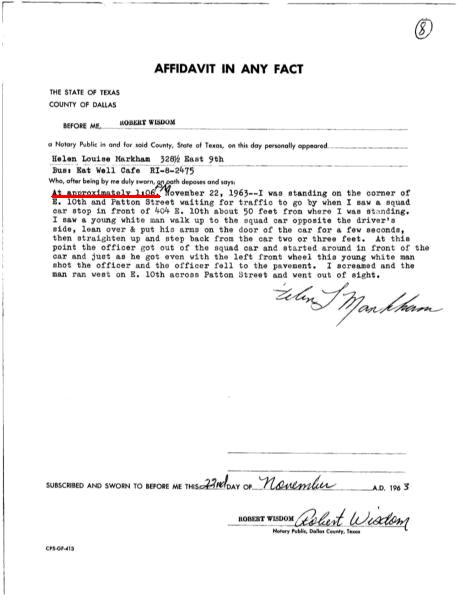


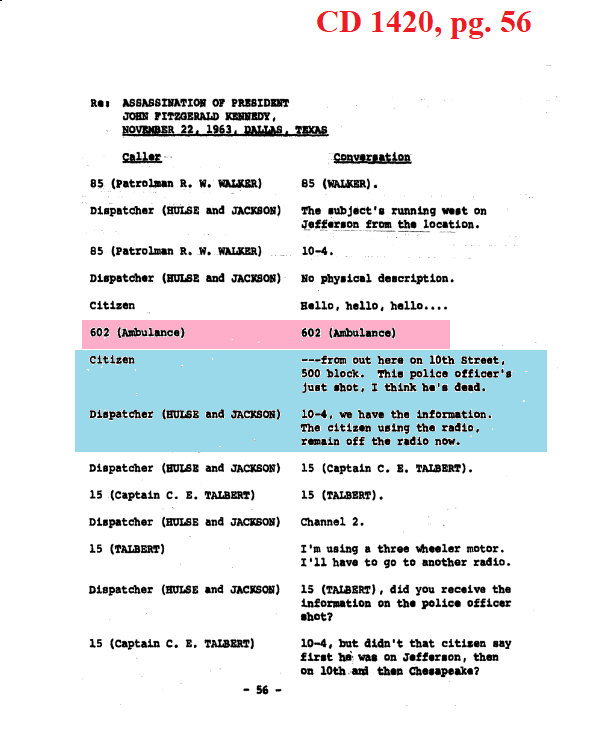
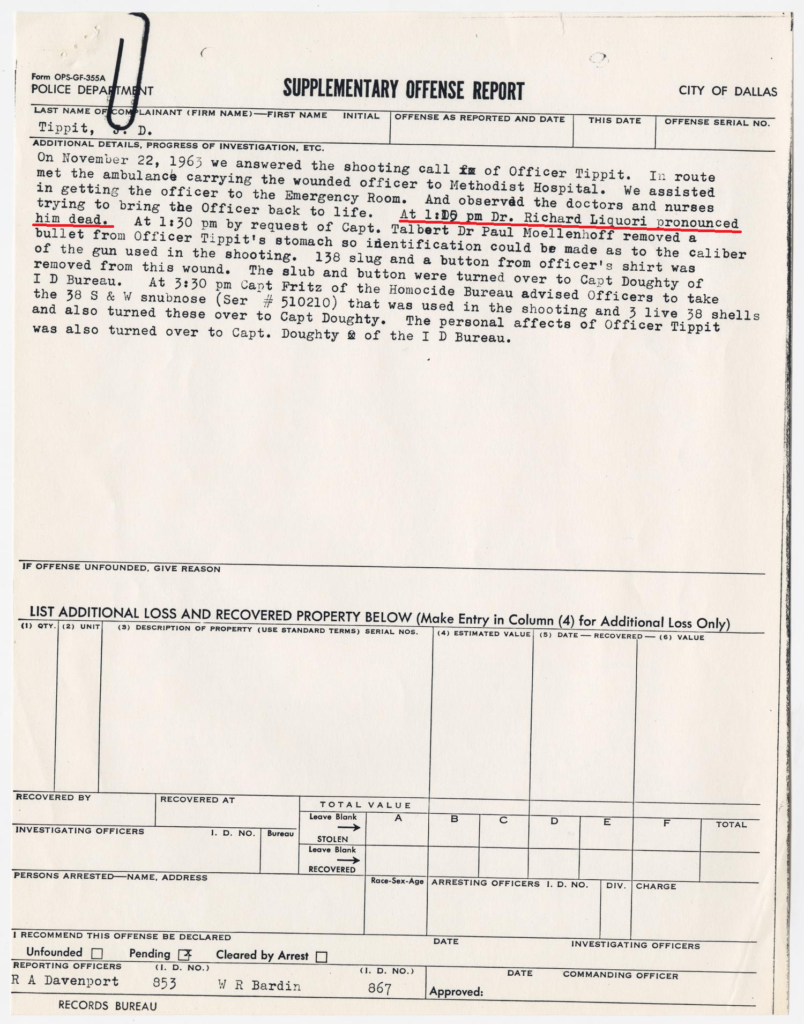
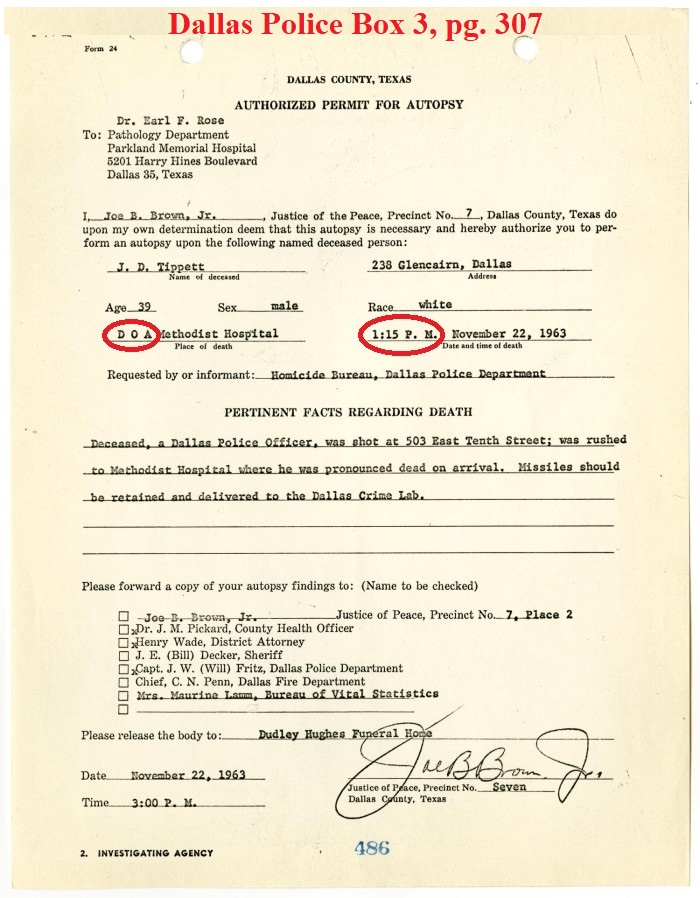
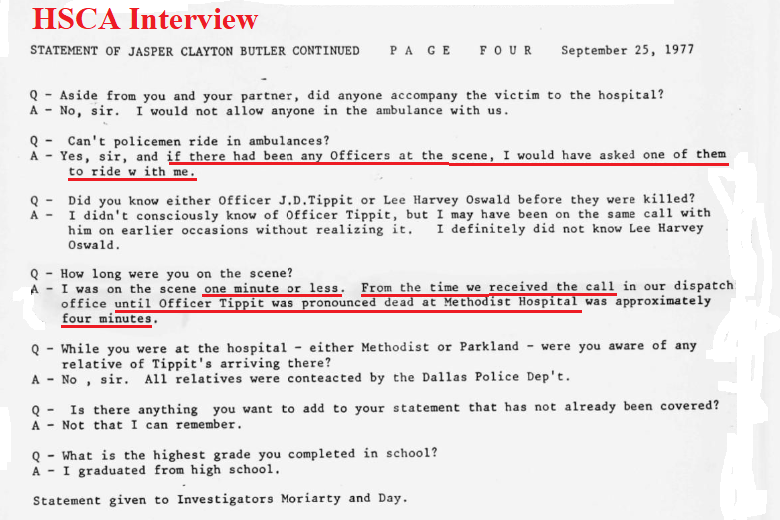
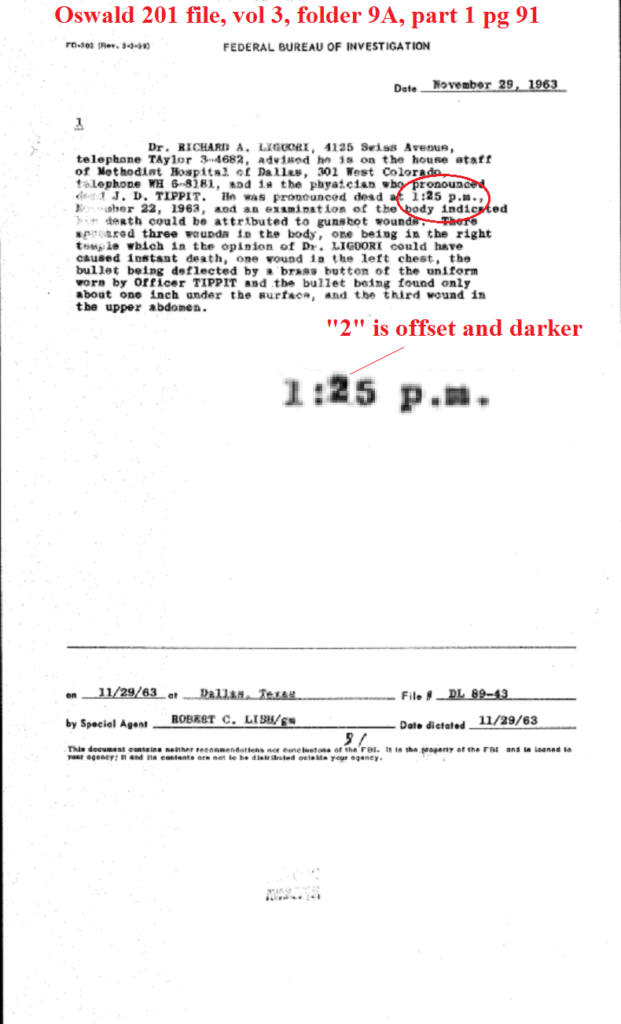
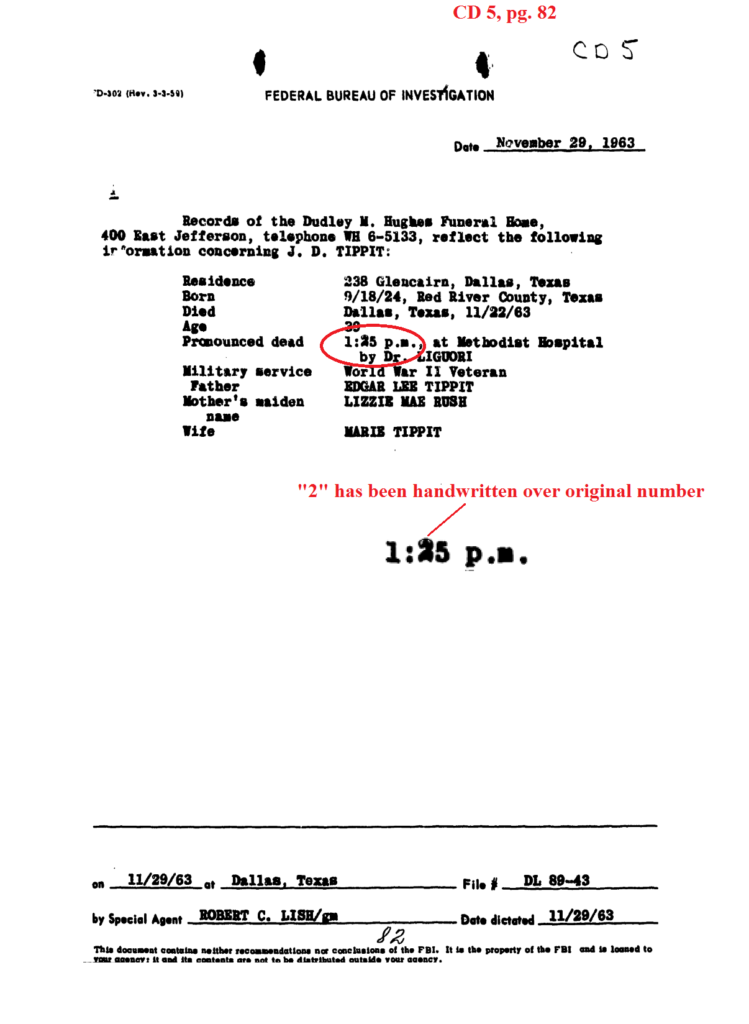
T.F. Bowley, A Wind-Up Wristwatch & 1:17
in JFK Assassination Debate
Posted
"Markham’s testimony on the lineup has been ridiculed since the 60s, because it’s ridiculous"
But, what you're forgetting is that you can set her 1964 testimony aside. It's completely unrelated to the fact that on 11.22.63, she picked Oswald as the man she saw shoot the policeman.
Her testimony in '64 does nothing to change what she did on 11.22.63